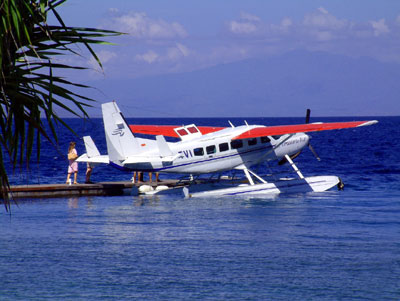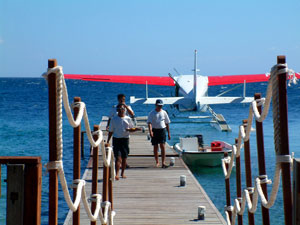Peace
on the Water -- Splendour in the Sky
Flying a Seaplane Beyond Bali
![]()
Originally written for the AmanResorts
Newsletter July 2003![]()

Amanwana or "peaceful forest" is a wilderness camp hidden away on the forested island of Moyo, a nature reserve east of Bali. Set in a secluded cove, the 20 luxury tents look out over the crystal-clear waters of the Flores Sea. The beauty of the place is found in the seclusion but that can also be a problem. There is no airport on the island and the boat trip is long and sometimes rough. What better way to arrive, however, than by a door-to-door seaplane shuttle that whisks you away from the security and comfort of the Bali International airport to land on the ocean directly in front of the Amanwana Resort. How one of the first commercially operated seaplanes in Indonesia began this milk run down the islands is another story, but the environmentally clean and quiet amphibious Caravan definitely suits the "at peace with nature" theme of Amanwana.

You start your flight with a normal check-in at the Domestic side of the Bali airport. The Captain
greets you as you on board and gives each passenger a personal safety briefing along with some
facts about the weather and the upcoming flight. When the aircraft starts you will be surprised at
how comfortable the leather seats are and how cool and comforting the ventilation system is.
The runway take-off is usually very smooth and the cabin noise level is low enough that you can
carry on a normal conversation during the flight. If you have ever flown on one of the domestic
airlines you would understand how these little facts can be very important.
The adventure really begins after take-off as you climb out over Benoa Harbour and follow the
south coast of Bali up along Sanur Beach and past Padangbai and the cliff side Amankila Resort.
From here you can often see Mt. Agung, the tallest volcano on Bali, and the sparkling green rice
terraces that grace its foothills. The pilot will continue to climb as you cross the Lombok strait
where the 12,296 ft high Mt. Rinjani happens to be right on your flight path on route to Moyo
Island.
Depending on the weather, your pilot will climb up to either 9,000 or 11,000 feet and fly along
the rim of the crater of this extraordinary work of nature. With only eight passenger seats and the
large bright windows everybody gets an up-front personal view of this fascinating jewel of
Lombok Island. To understand what a privilege it is to experience this splendour in the sky you
have to spend a few moments getting to know it better. Let me introduce you.
Mt. Rinjani is an active volcano that created the island of Lombok.
Everybody who lives on the island of Lombok owes his or her existence
and their livelihood to the volcano. The inevitable if irregular
eruptions not only created the land they stand on, but also enrich the
soil for a bountiful harvest. The tropical rain that falls on the island
nurtures the lush green forests and
terraced rice fields that symbolize this exotic region of Indonesia.
Ying and Yang, good and evil, life and death, and all the other
polar opposites best describe the
condition of living on Lombok or within the vicinity of any other volcano for that matter. Shaken
by the sporadic and unpredictable eruptions it's no wonder that the people of Lombok worship
the spirit of the fiery inverted-cone shaped mountain. They celebrate its very existence and are
careful not to enrage the spirits in charge. Don't rock the boat. Don't spit into the wind. And
don't tug on Superman's cape.
What is not so obvious about the power of the 12,296 ft Mt. Rinjani, however, is that somewhere
in the distant past an enormous explosion tore off the top of a larger 15,000 ft volcano and left a
gaping crater large enough to place a small city within. Anyone living below the mountain would
have little idea of the crater's depth or magnitude. Down in hot and humid Mataram, the capital
of Lombok, most people have no idea of what Rinjani represents. It is only for the privileged few
that can make the difficult sojourn that the spirit of the place becomes obvious.
With thousands of years of tropical rain swelling up inside the volcano, the vast crater basin now
holds the large and deep opaque emerald green Segara Anak Lake whose surface sits at about
6300 ft elevation above sea level. Another unique feature in that in the midst of its large expanse
-- about five kilometers long and three kilometers wide – there sits a 200 year old secondary "child" cone protruding
out of the east end. The tall straight pine trees gracing the landscape, and looking like something
out of Myst or descendants from the Mesozoic period, blend in well with the alpine atmosphere.
In the clear cool air you can make out the steam rising from the "child" volcano cone.
Surprisingly that peaceful looking cone last erupted in 1994 spilling out what appears to be a
fresh flow of black lava down to below the lake's surface.
Adding to the expansive feeling of grandeur the surrounding crater
rim extends upward another three to four thousand feet to create a continuous enclosure looking so much like a crumbled wall of an
ancient Roman coliseum. The only exception is where the initial explosion, or later erosion,
created a narrow gap in the north end. Here the excess rainwater flows out forming a waterfalls
and a river that flows to the sea. When the cone last erupted the lake consequently overflowed
killing 35 villagers along the otherwise serene mountain river.
The normal way of getting to this wondrous lake and for that matter to the volcano peak is to
hike up. Both the Balinese and the Muslim Sasak of Lombok Island make a pilgrimage to toss
ritual rice, green banana leaves, saffron coloured flowers and goldfish into the clear mountain
waters. But, getting there is not easy. It takes two days of slogging up a tropical rainforest trail –
hampered by heat, insects, thieving monkeys, washed out footpaths, and hypothermic nights -- to
make the rim at sunrise.
Despite being considered "worthwhile" the climb is also considered
dangerous. Numerous people have died trekking Rinjani in the last few years. Comfort and safety
are two good reasons to experience the awesome majesty of this splendour in the sky from inside
the Caravan, but the main reason is one of perspective. You get to explore the world from the
perspective of the select few who view the earth from above. As a once in a lifetime experience
you will get to share in watching the earth revolve and evolve beneath you as only a bush pilot
can.
As you leave the island of Lombok and cross the Atlas strait you can continue to "look out
below." Watching the waters along the North Coast of Sumbawa Island can be a rewarding
experience. As we come closer to Moyo Island we often see hundreds of shoals of schooling fish
being herded and harassed by tuna and barracuda. On several occasions we have seen whales, but
the most popular sighting is the literally hundreds of dolphins as they hunt for fish.

My favorite sea creatures, however, are the large black and white manta rays that inhabit the waters near the resort. As they "fly" along the surface of the water and do barrel rolls and loops they look like an aerobatic team in full swing. The possibility of a sighting is so engrossing that before you realize it the pilot is asking you to fasten your seatbelt for the seaplane landing. The pilot flies over the resort in a wide graceful turn, so you can have a quick look at your new home away from home, before landing gently on the brilliant clear ocean waters. Within moments you are walking, tropical drink and a cooling towel in hand, up the jetty into the peaceful forest of Amanwana. It is that simple.

Article and Images by John S Goulet
![]()
The attitude indicator will guide you back to Feature Stories.
 Top of this story.
Top of this story.
Last modified on
June 15, 2006 .
© Virtual Horizons, 1996.